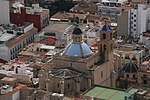Estadio José Rico Pérez
1974 establishments in Spain1982 FIFA World Cup stadiumsAlicante CFBuildings and structures in AlicanteFootball venues in the Valencian Community ... and 4 more
Hércules CFMulti-purpose stadiums in SpainSpanish sports venue stubsSports venues completed in 1974

Estadio José Rico Pérez is a multi-purpose stadium in Alicante, Spain. It is currently used mostly for football matches, being home to Hércules CF. It also hosted World Cup matches when Spain organized the event in 1982. With a capacity of 29,500 seats, it is the 19th-largest stadium in Spain and the 3rd-largest in the Valencian Community. It was built in 1974, and is situated 2 miles outside Alicante city centre. The stadium is named after the former chairman of Hércules CF, José Rico Pérez.
Excerpt from the Wikipedia article Estadio José Rico Pérez (License: CC BY-SA 3.0, Authors, Images).Estadio José Rico Pérez
calle escultor Bañuls, Alicante Campoamor
Geographical coordinates (GPS) Address External links Nearby Places Show on map
Geographical coordinates (GPS)
| Latitude | Longitude |
|---|---|
| N 38.357222222222 ° | E -0.4925 ° |
Address
Estadio José Rico Pérez
calle escultor Bañuls
03009 Alicante, Campoamor
Valencian Community, Spain
Open on Google Maps








